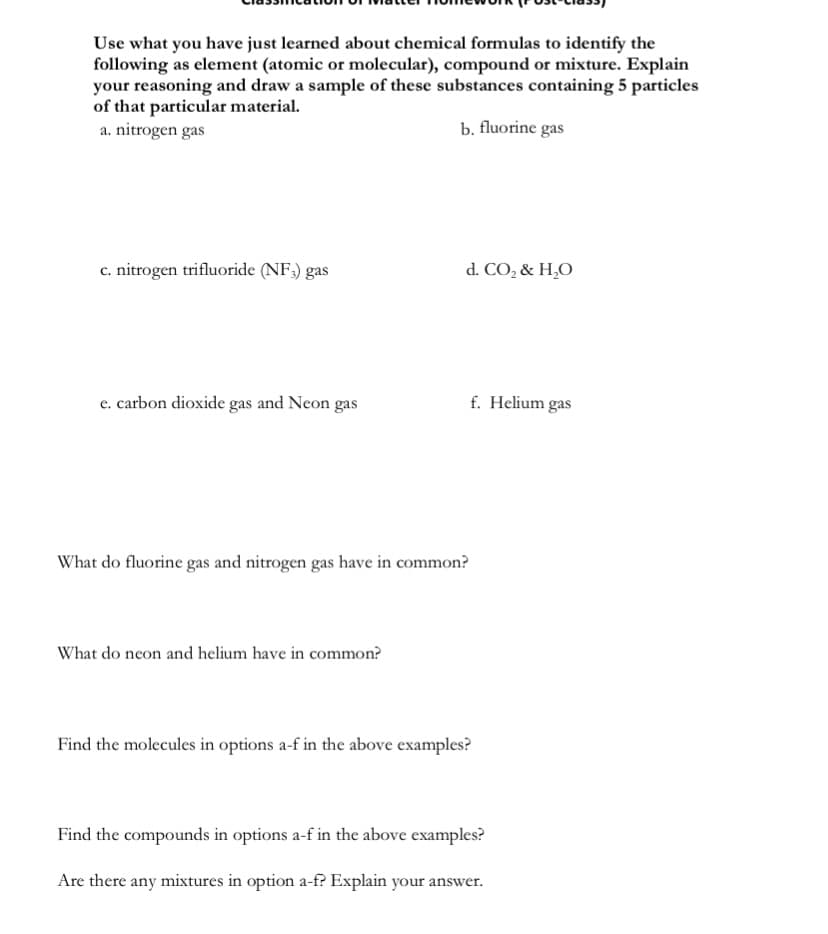Use what you have just learned about chemical formulas to identify the following as element (atomic or molecular), compound or mixture. Explain your reasoning and draw a sample of these substances containing 5 particles of that particular material. a. nitrogen gas b. fluorine gas c. nitrogen trifluoride (NF;) gas d. CO, & H,O c. carbon dioxide gas and Neon gas f. Helium gas What do fluorine gas and nitrogen gas have in common? What do neon and helium have in common? Find the molecules in options a-f in the above examples? Find the compounds in options a-f in the above examples? Are there any mixtures in option a-f? Explain your answer.
Use what you have just learned about chemical formulas to identify the following as element (atomic or molecular), compound or mixture. Explain your reasoning and draw a sample of these substances containing 5 particles of that particular material. a. nitrogen gas b. fluorine gas c. nitrogen trifluoride (NF;) gas d. CO, & H,O c. carbon dioxide gas and Neon gas f. Helium gas What do fluorine gas and nitrogen gas have in common? What do neon and helium have in common? Find the molecules in options a-f in the above examples? Find the compounds in options a-f in the above examples? Are there any mixtures in option a-f? Explain your answer.
Introductory Chemistry: A Foundation
9th Edition
ISBN:9781337399425
Author:Steven S. Zumdahl, Donald J. DeCoste
Publisher:Steven S. Zumdahl, Donald J. DeCoste
Chapter4: Chemical Foundations: Elements, Atoms, And Ions
Section: Chapter Questions
Problem 10ALQ: These questions concern the work of J. J. Thomson: From Thomson’s work, which particles do you think...
Related questions
Question
Please help me answer this

Transcribed Image Text:Use what you have just learned about chemical formulas to identify the
following as element (atomic or molecular), compound or mixture. Explain
your reasoning and draw a sample of these substances containing 5 particles
of that particular material.
a. nitrogen gas
b. fluorine gas
c. nitrogen trifluoride (NF;) gas
d. CO, & H,O
c. carbon dioxide gas and Neon gas
f. Helium gas
What do fluorine gas and nitrogen gas have in common?
What do neon and helium have in common?
Find the molecules in options a-f in the above examples?
Find the compounds in options a-f in the above examples?
Are there any mixtures in option a-f? Explain your answer.
Expert Solution
This question has been solved!
Explore an expertly crafted, step-by-step solution for a thorough understanding of key concepts.
This is a popular solution!
Trending now
This is a popular solution!
Step by step
Solved in 3 steps with 2 images

Knowledge Booster
Learn more about
Need a deep-dive on the concept behind this application? Look no further. Learn more about this topic, chemistry and related others by exploring similar questions and additional content below.Recommended textbooks for you

Introductory Chemistry: A Foundation
Chemistry
ISBN:
9781337399425
Author:
Steven S. Zumdahl, Donald J. DeCoste
Publisher:
Cengage Learning

Chemistry & Chemical Reactivity
Chemistry
ISBN:
9781133949640
Author:
John C. Kotz, Paul M. Treichel, John Townsend, David Treichel
Publisher:
Cengage Learning

Chemistry & Chemical Reactivity
Chemistry
ISBN:
9781337399074
Author:
John C. Kotz, Paul M. Treichel, John Townsend, David Treichel
Publisher:
Cengage Learning

Introductory Chemistry: A Foundation
Chemistry
ISBN:
9781337399425
Author:
Steven S. Zumdahl, Donald J. DeCoste
Publisher:
Cengage Learning

Chemistry & Chemical Reactivity
Chemistry
ISBN:
9781133949640
Author:
John C. Kotz, Paul M. Treichel, John Townsend, David Treichel
Publisher:
Cengage Learning

Chemistry & Chemical Reactivity
Chemistry
ISBN:
9781337399074
Author:
John C. Kotz, Paul M. Treichel, John Townsend, David Treichel
Publisher:
Cengage Learning

Chemistry: An Atoms First Approach
Chemistry
ISBN:
9781305079243
Author:
Steven S. Zumdahl, Susan A. Zumdahl
Publisher:
Cengage Learning


Chemistry
Chemistry
ISBN:
9781305957404
Author:
Steven S. Zumdahl, Susan A. Zumdahl, Donald J. DeCoste
Publisher:
Cengage Learning